Related Research Articles

A cyborg —a portmanteau of cybernetic and organism—is a being with both organic and biomechatronic body parts. The term was coined in 1960 by Manfred Clynes and Nathan S. Kline. In contrast to biorobots and androids, the term cyborg applies to a living organism that has restored function or enhanced abilities due to the integration of some artificial component or technology that relies on feedback.

The Ferrocarriles del Ecuador Empresa Pública is the national railway of Ecuador. The railway system was devised to connect the Pacific coast with the Andean highlands. After many decades of service the railway was severely damaged by heavy rainfall during the El Niño in 1997 and 1998 and from general neglect as the Pan-American Highway siphoned off passengers.
The Amazon Defense Coalition is an Ecuadorian non-governmental organization created on May 16, 1994, and approved by the Ecuadorian Ministry of Social Welfare on June 4, 1998, under ministerial reference #535. It is led by the environmental and human rights activist Luis Yanza.

An eyeborg or eye-borg is a body modification apparatus which fits on the wearer's head, and is designed to allow people to perceive color through sound waves. It works with a head-mounted antenna that senses the colors directly in front of a person, and converts them in real-time into sound waves through bone conduction.

The Fundación Picasso, also known as the Pablo Ruiz Picasso Foundation, is a foundation based in Málaga, Andalusia, Spain with the objective of promoting and promulgating the work of the artist Pablo Picasso. They are headquartered in the home on the Plaza de la Merced that was his birthplace, now the Museo Casa Natal, one of the world's many Picasso museums.

Neil Harbisson is a Catalan-raised British-Irish-American cyborg artist and activist for transpecies rights. He is best known for being the first person in the world with an antenna implanted in his skull. He has described himself as the world's first legally recognised cyborg and The Guardian called him the world's first cyborg artist. His antenna sends audible vibrations through his skull to report information to him. This includes measurements of electromagnetic radiation, phone calls, and music, as well as videos or images which are translated into audible vibrations. His WiFi-enabled antenna also allows him to receive signals and data from satellites.
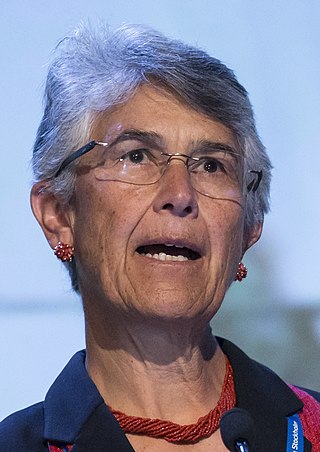
Yolanda Kakabadse Navarro is an Ecuadorian conservationist of Georgian descent.
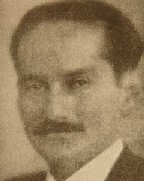
Luciano Durán Böger was a Bolivian poet, writer and politician. Son of Luciano Duran Pérez and Aurora Böger Rivero, was born in 1904 in Santa Ana, capital of the Yacuma province of the Department of Beni in Bolivia, and died in 1996 in the city of La Paz.
Sonochromatism or sonochromatopsia is a neurological phenomenon in which colours are perceived as sounds. The phenomenon is created by the union between a brain and a colour-to-sound software or chip. People who report such experiences are known as sonochromats. The term was coined by Neil Harbisson to differentiate his experience of colour from people with chromesthesia or colour-to-sound synesthesia.
A cyborg antenna is an osseointegrated device implanted in a human skull. The antenna, composed of a wireless camera on one end and a wireless sound vibration implant on the other end, allows wireless communication and wireless transmission of images, sound or video from skull to skull. The antenna uses audible vibrations in the skull to report information. This includes measurements of electromagnetic radiation, phone calls, music, as well as video or images which are transmitted through audible vibrations. The Wi-Fi enabled antenna also allows the reception signals and data from satellites.
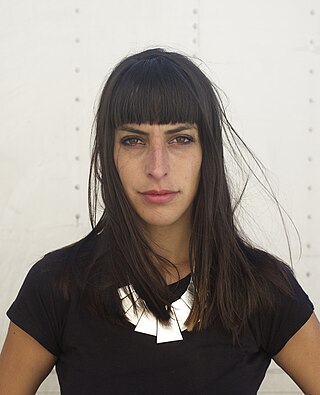
Moon Ribas is a Spanish avant-garde artist and cyborg activist best known for developing and implanting online seismic sensors in her feet that allow her to feel earthquakes through vibrations. Since 2007, international media have described her as the world's first cyborg woman or the world's first female cyborg artist. She is the co-founder of the Cyborg Foundation, an international organisation that encourages humans to become cyborgs and promotes cyborgism as an art movement and the co-founder of the Transpecies Society, an association that gives voice to people with non-human identities and offers the development of new senses and organs in community. Her choreography works are based on the exploration of new movements developed by the addition of new senses or sensory extensions to the dancer.

Cyborg art, also known as cyborgism, is an art movement that began in the mid-2000s in Britain. It is based on the creation and addition of new senses to the body via cybernetic implants and the creation of art works through new senses. Cyborg artworks are created by cyborg artists; artists whose senses have been voluntarily enhanced through cybernetic implants. Among the early artists shaping the cyborg art movement are Neil Harbisson, whose antenna implant allows him to perceive ultraviolet and infrared colours, and Moon Ribas whose implants in her feet allow her to feel earthquakes and moonquakes. Other cyborg artists include:
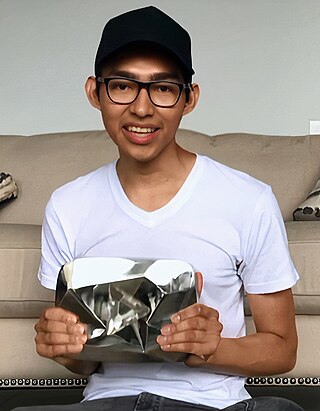
Luis Fernando Flores Alvarado, better known as Fernanfloo, is a Salvadoran gaming and comedy YouTuber. He has uploaded more than 544 videos, with over 10 billion total views. His channel has 46 million subscribers. As of July 2023, his channel is the 48th-most-subscribed channel on YouTube, and the fourth most-subscribed Spanish-speaking channel behind El Reino Infantil, Badabun and JuegaGerman. He is currently the most subscribed channel in El Salvador and Central America.
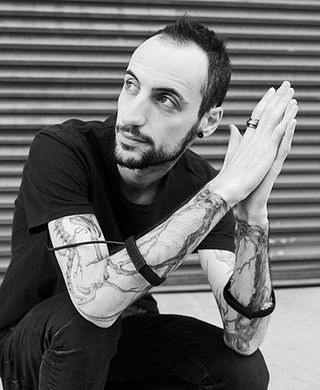
Marco Donnarumma is an Italian performance artist, new media artist and scholar based in Berlin. His work addresses the relationship between body, politics and technology. He is widely known for his performances fusing sound, computation and biotechnology. Ritual, shock and entrainment are key elements to his aesthetics. Donnarumma is often associated with cyborg and posthuman artists and is acknowledged for his contribution to human-machine interfacing through the unconventional use of muscle sound and biofeedback. From 2016 to 2018 he was a Research Fellow at Berlin University of the Arts in collaboration with the Neurorobotics Research Lab at Beuth University of Applied Sciences Berlin. In 2019, together with bioartist Margherita Pevere and media artist Andrea Familari, he co-founded the artists group for hybrid live art Fronte Vacuo.
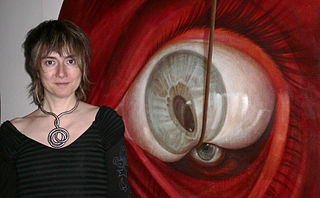
Marina Núñez is a Spanish artist, and a professor at the University of Vigo. Her work is included in the collections of Museo Nacional Centro de Arte Reina Sofía in Madrid, Artium in Vitoria, MUSAC in Leon, Patio Herreriano in Valladolid, TEA in Tenerife, Fundación La Caixa, Fundación Botín, Corcoran Gallery of Art in Washington, DC, National Museum of Women in the Arts in Washington DC, Mint Museum of Art in Charlotte, North Carolina, Katzen Arts Center, American University Museum, in Washington DC, Fonds régional d'art contemporain in Corsica, France.

Manel De Aguas Muñoz, known artistically as Manel De Aguas, is a Spanish cyborg artist and transpecies activist based in Barcelona, best known for developing and installing weather sensory fins in his head. The fins, formally known as 'Weather Fins', allow him to hear atmospheric pressure, humidity and temperature changes through implants at each side of his head. Depending on the changes he feels, he can predict weather changes as well as sense his current altitude.
The Jaime Brunet International Prize was established in 1998 with the objective of distinguishing people, organizations and institutions that promote the defence of human rights. It is awarded by the Jaime Brunet Foundation of the UPNA. This award also aims to recognize the work of those who fight to eliminate situations of inhumane or degrading treatment in violation of people's inherent rights to dignity. The prize consists of a diploma, a sculpture commemorating the award and €36,000 in cash.
Asha Ismail is a Kenyan human rights activist. She is the founder and president of Save a Girl, Save a Generation, an organisation whose mission is to end female genital mutilation, the dowry system, forced marriage and other abuses against women in Africa and Asia.

The Doctor Juan Abarca International Award in Medical Sciences, known as the Abarca Prize, is an award that recognises research and innovation through a biomedical finding of global significance.

CyborgNest Ltd is a company headquartered in London, United Kingdom. The start-up was the first in the world to commercialise sensory enhancement technology and created a wearable which used haptic technology (vibrations) to convey information to the wearer called NorthSense. The device was released in 2017 to connect wearers to the Earth's magnetic field.
References
- ↑ García, F.C. "Nace una fundación dedicada a convertir humanos en ciborgs", La Vanguardia , 1 March 2011.
- ↑ Rottenschlage, Andreas "The Sound of the Cyborg" The Red Bulletin , 1 Mar 2011.
- ↑ Redacción "Asombrados por un cyborg. La Universidad Modelo recibe a Neil Harbisson" [ permanent dead link ], Diario de Yucatan, 17 November 2011
- ↑ Molinsky, Eric "Neil Harbisson, cyborg" Archived 2012-04-28 at the Wayback Machine , Studio 360, WNYC, 4 November 2011
- ↑ EFE "Tecnologia cyborg para la vision" Archived 2014-08-08 at the Wayback Machine , EFE, 27 October 2011
- ↑ Maia, Rafael "Nao quero vender olhos", Terra Networks, 9 February 2012.
- ↑ Calls, Albert "“Les noves tecnologies seran part del nostre cos i extensió del cervell”" [ permanent dead link ]La Tribuna, 3 Jan 2011.
- ↑ EFE "Tecnologia cyborg para la vision" Archived 2014-08-08 at the Wayback Machine , EFE, 27 October 2011
- ↑ Redacción "Una fundación se dedica a convertir humanos en ciborgs" El Comercio (Peru) , 1 Mar 2011.
- ↑ Martínez, Ll. "La Fundació Cyborg s'endú el primer premi dels Cre@tic", Avui , 20 Nov 2010
- ↑ Kilday, Gregg (2013-01-22). "Sundance 2013: Rafel Duran Torrent wins Focus Forward Filmmaker Competition Grand Jury Prize". The Hollywood Reporter. Retrieved 2021-06-06.
- ↑ Redaccion "Gobierno impulsara plan para no videntes" Archived 2016-08-03 at the Wayback Machine , El Tiempo (Ecuador), 30 October 2011.
- ↑ Redação "Primeiro ciborgue do mundo estará nesta quarta na UPE" Archived 2012-05-12 at the Wayback Machine , Diário de Pernambuco , 30 April 2012
- ↑ Lins, Letícia "Homem-ciborgue desenvolve projeto no Brasil", O Globo , 2 May 2012
- ↑ "Sense Hacking: The Real-Life Cyborgs of the DIY Augmentation Scene". How We Get To Next. 2017-08-15. Retrieved 2017-12-06.
- 1 2 https://www.cyborgfoundation.com/
